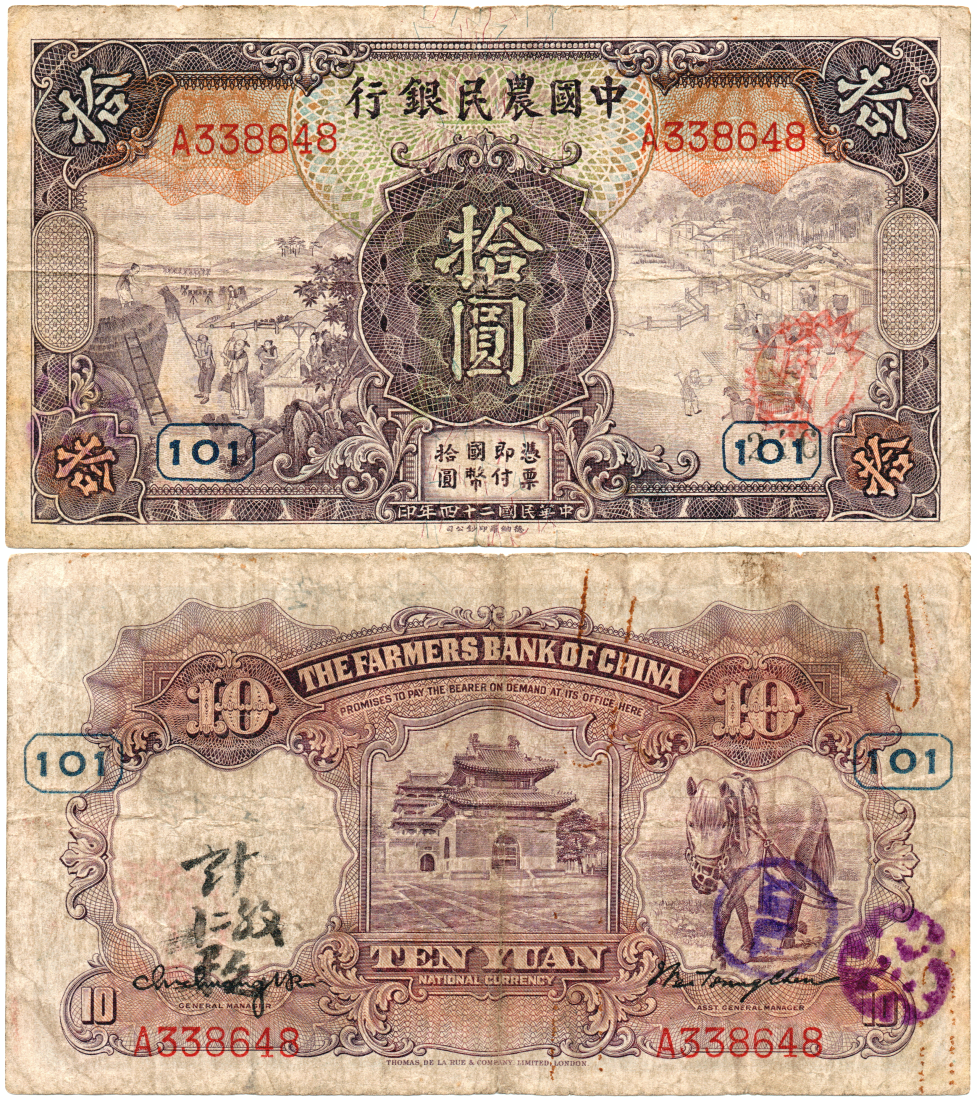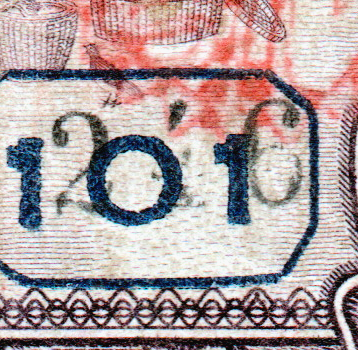|
|
Updated August 29 2020
|
Script, Scrawl and Chops (4)
A study of various examples of unofficial additions to paper money, usually in the form of various written scripts, signatures or chops (seals), continued. This page focuses on examples of Farmers Bank of China notes.
The Agricultural Bank of the Four Provinces - 四省農民銀行
|
The Agricultural Bank of the Four Provinces (established 1933) was reorganised to become the Farmers Bank of China in 1935. Right: The Agricultural Bank of the Four Provinces 1 yuan of 1934, Foochow (Fuzhou) branch. SCWPM A91Ea, S/M C110-30. A well used note with at least 16 chops and annotations across both sides, unfortunately generally illegible. The one identifiable chop, is the square framed 活 on the back; variously translated as "to live; alive; living; work; workmanship" |
The Farmers Bank of China - 中國農民銀行
|
Right: The Farmers Bank of China 20 cents of 1935, SCWPM 454, S/M C290-20a, first signature type. Three markings to note: The most obvious is the large bilingual commercial stamp on the front of the note, for a business in Shanghai 上海. The romanization of the name is not Wade Giles; Zan(?) Yih San (山 shan, 一 yi, ? san). Unfortunately the first (right to left) character is too blotchy to determine. On the back there is 25/4 possibly meaning March 25th? At the top the name S.S. Dyien. A person? A ship? |
|
Right: The Farmers Bank of China 10 yuan of 1935, SCWPM 459, S/M C290-32, first signature type, c1935. A scarce type with officially added control overprints ('101'), however another unofficial number, '246' has been added over the right overprint on the front. This is in turn adjacent to an unusual oval red chop with a flared/spiked frame. A further couple of distinctive purple/violet chops and a rapidly written annotation are found on the back. Below (left): the '246' overprint as described above (Centre-left): an enhanced/restored image revealing the unexpected details of the red oval chop on the front. This appears to consist of a 'V' and an 'S' divided by chevrons, with a Chinese character at right which seems to be 九, '9'. (Centre-right): a chop with roman alphabet initials (or a name), apparently 'T' 'O' (or Q?) 'R' (B?) and 'Y' (Right): a crude chop which appears to contain the obscure character 㻊, meaning unknown. |
|
Right: The Farmers Bank of China 10 yuan of 1941, SCWPM 459, S/M C290-32, second signature type, c1937. An extensive series of related annotations across both sides of the note relating to an Allied serviceman's time across southern China. From the back: "Feb.15, 1945 T/Sgt. Edward K. Lynch, 6863085 75th Fighter Sq(uad)., 23rd Fighter Group 14th Army Air Force July 4, 1942 to Sept.27, 1944" A description of the declining value of the 10 yuan note: 1937 worth $3.30 1942 " .50 1945 " .05¢ The Front: Hengyang (city in Hunan Province), Lingling (now Yongzhou city, Hunan), Kweilin (Guilin city, Kwangsi/Guangxi province), Kunming (Yunnan province), Yu-nan-yi (Yunnan-Yi town, Yunnan), Chanyi (Zhanyi, then an airport and military base in Yunnan), Kutsing (a town/district in eastern Yunnan), Luiliang (Luliang, an airbase in Yunnan) |
|
Above and below: the ruins of Hengyang following the 1944 siege (Life).
|
The one certain reference found for Edward K Lynch is an entry in the Air Force Register of 1956, showing that he retired from the airforce in February 1955.
The 75th Fighter Squadron was established December 17, 1941. The first assignment as an active unit was in the China-Burma-India theatre; there was a major victory against Japanese bombers on the first day of activation. Some members of the American Volunteer Group known as the "Flying Tigers" joined the 75th Fighter Squadron after the AVG was disbanded. Hengyang city (aka Hengchow) was an important rail junction, and the location of a crucial airbase used by the Flying Tigers. Due to this, the Japanese attacked on June 22nd 1944, leading to an infamous 48 day siege in which over 17,000 Chinese troops, 19,000 (or up to 60,000) Japanese troops, and 3100 civilians died. The city was virtually destroyed. Japan won, but at great cost. Chanyi (Zhanyi) airbase was primarily a reconnaissance base, with photo mapping and combat aerial photography units flying missions over Japanese-held territory from September 1944 until September 1945. Luiliang airbase was the primary home of the 23d Fighter Group (Flying Tigers), and its command and control organisation; the 68th Composite Wing, beginning in September 1944 until the war ended in 1945. It is still used by the People's Liberation Army. |
|
Right: The Farmers Bank of China 5 yuan of 1941, SCWPM 475, S/M C290-81. A 'late' chop mark, as such overprints are far less commonly found on notes during the 1940s, however the explanation was soon provided through translation. Allied servicemen fighting in China during 1941-1945 or stationed there after, often posted or took currency items back home. These are often seen with handwritten signatures and inscriptions including the world "souvenir". Amusingly, that's what the Chinese script translates to, 紀念品 The central character is written unusually so it doesn't appear exactly the same, which caused confusion for a while. |
Study in progress...
|
Right: The Farmers Bank of China 5 yuan of 1941, SCWPM 475, S/M C290-81. An unusual example. The Chinese characters for Shanghai 上海 (rubbed) have been written on the front at left and right in the cartouches designed but never officially used for such. The back of the note is covered by 5 columns of handwritten Chinese text running vertical against the horizontal alignment of the note. Wear to the writing including fold cracks show that this note was used for some time after the writing was added, though whether for its intended use depends on the purpose of the writing. |
|
There have been difficulties in trying to identify many of the characters. The problem of traditional Chinese (which most Chinese people now cannot read apparently), is made considerably worse by this text being written in semi-cursive script (everyday handwriting in other words).
The example chart to the right shows the problem, especially to anyone unfamiliar with handwritten Chinese text. Even many native Chinese speakers have problems reading the cursive script as shown at the bottom. |
From right to left:
Line 1: 詩, (unknown, with radical 宀), 伟(?), 景, 在, 新, ?, ?, ?, 黃, 丰, 未
Line 2: ?, ?, ?, 上, 林, ? (radical possibly 乙), ? (radical possibly 人), 錦, ?, 俔, ...
Line 3: ?, 人,
Line 4:
Line 5: 民, 國, 三, ?, 年, ?, 囯, ?, 伍, ?, 正
Line 1: 詩, (unknown, with radical 宀), 伟(?), 景, 在, 新, ?, ?, ?, 黃, 丰, 未
Line 2: ?, ?, ?, 上, 林, ? (radical possibly 乙), ? (radical possibly 人), 錦, ?, 俔, ...
Line 3: ?, 人,
Line 4:
Line 5: 民, 國, 三, ?, 年, ?, 囯, ?, 伍, ?, 正













